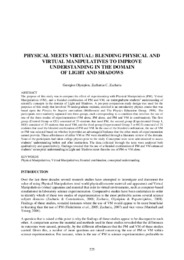Physical meets virtual: blending physical and virtual manipulatives to improve understanding in the domain of light and shadows
Abstract
The purpose of this study was to compare the effect of experimenting with Physical Manipulatives (PM), Virtual Manipulatives (VM), and a blended combination of PM and VM, on undergraduate students’ understanding of scientific concepts in the domain of Light and Shadows. A pre-post comparison study design was used for the purposes of this study that involved 70 undergraduate students, enrolled in an introductory physics course that was based upon the Physics by Inquiry curriculum (McDermott and The Physics Education Group, 1996). The participants were randomly separated into three groups, each corresponding to a condition that involves the use of one of the three modes of experimentation (VM alone, PM alone, and PM and VM in combination). The first group (Control Group or CG) consisted of 23 students that used PM, the second group (Experimental Group 1, EG1) consisted of 23 students that used VM, and the third group (Experimental Group 2 or EG2) consisted of 24 students that used the blended combination of PM and VM. In the case of the blended combination, the use of VM or PM was selected based on whether it provides an advantage/affordance that the other mode of experimentation cannot provide. These affordances of either VM or PM were identified through a literature review of the domain. None of the participants had taken college physics prior to the study. Conceptual tests were administered to assess students’ understanding before and after instruction. The data collected through the tests were analyzed both qualitatively and quantitatively. Findings revealed that the use of a blended combination of PM and VM enhanced students’ conceptual understanding in Light and Shadows more than the use of PM or VM alone.
